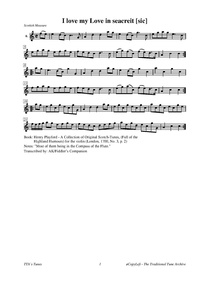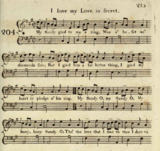Template:Pagina principale/Vetrina: Difference between revisions
No edit summary |
No edit summary |
||
| Line 1: | Line 1: | ||
{{SheetMusic | {{SheetMusic | ||
|f_track= | |f_track=I Love My Love In Secret.mp3 | ||
|f_pdf= | |f_pdf=I love my Love in secret.pdf | ||
|f_artwork= | |f_artwork=I Love my Love in Secret.png | ||
|f_tune_name= | |f_tune_name=I Love My Love in Secret | ||
|f_track_title= | |f_track_title=I Love My Love in Secret | ||
|f_section= | |f_section=X1 | ||
|f_played_by=[https://soundcloud.com/ | |f_played_by=[https://soundcloud.com/user654240642 Matt Seattle & Friends] | ||
|f_notes= | |f_notes= I Love my Love in Secret Manuscript. | ||
|f_caption= | |f_caption=My Sandy gied to me a ring {{break}} | ||
|f_source=[https:// | Was a' beset wi' diamonds fine;{{break}} | ||
But I gied him a far better thing,{{break}} | |||
I gied my heart in pledge o' his ring.{{break}} | |||
|f_source=[https://tunearch.org/wiki/I_Love_My_Love_in_Secret Soundcloud] | |||
|f_pix=420 | |f_pix=420 | ||
|f_picpix=200 | |f_picpix=200 | ||
|f_article=[[ | |f_article=[[I Love My Love in Secret | '''I Love My Love in Secret''']] | ||
It was the custom in Scotland for lovers to break a silver coin prior to a necessary separation, each keeping a piece as a pledge to be faithful during absence. | |||
"I love my love in secret" was contained in the Northumbrian music manuscript collection of John Smith, dated 1752, unfortunately now lost. | |||
The contents were copied by 19th century folk-music collector John Stokoe in 1887, when the manuscript was in the possession of Lewis Proudlock. | |||
Stokoe's volume Northumbrian Minstrelsy had been printed five year prior, and his interest in Smith’s ms. demonstrates Stokoe's continuing commitment to older Northumbrian music. | |||
The tune was also entered into the large 1840 music manuscript collection of multi-instrumentalist John Rook, of Waverton, near Wigton, Cumbria, as "I love my lass in secret". | |||
}} | }} | ||
Revision as of 11:53, 7 January 2024

Was a' beset wi' diamonds fine;
But I gied him a far better thing,
I gied my heart in pledge o' his ring.
Played by: Matt Seattle & Friends
Source: Soundcloud
Image: I Love my Love in Secret Manuscript.

It was the custom in Scotland for lovers to break a silver coin prior to a necessary separation, each keeping a piece as a pledge to be faithful during absence.
"I love my love in secret" was contained in the Northumbrian music manuscript collection of John Smith, dated 1752, unfortunately now lost.
The contents were copied by 19th century folk-music collector John Stokoe in 1887, when the manuscript was in the possession of Lewis Proudlock.
Stokoe's volume Northumbrian Minstrelsy had been printed five year prior, and his interest in Smith’s ms. demonstrates Stokoe's continuing commitment to older Northumbrian music.
The tune was also entered into the large 1840 music manuscript collection of multi-instrumentalist John Rook, of Waverton, near Wigton, Cumbria, as "I love my lass in secret".
...more at: I Love My Love in Secret - full Score(s) and Annotations
X:1 T:I love my Love in secret M:C L:1/8 B:David Young - "A Collection of Scotch Airs with the latest Variations" (AKA - The B:McFarlane Manuscript (c. 1741, No. 155, p. 210) F: https://rmacd.com/music/macfarlane-manuscript/collection/pdfs/i_love_my_love_in_secret.pdf N:The Society of Antiquaries of Scotland K:Bb V:1 clef=treble name="1." [V:1] (fe)|d2 (cB) TB3F|G2 (cd) Tc2 (gf)|d2 (cB) f2B2|efgf Td2 (cB)|e(f/g/) fe defd| edTcB Tc3B|(dfg)B fd Tc>B|G2 (Bc) B2::T(fe)|d2 (cB) TB3F|G2 (cd) Tc2 Tfe| d2 (cB) Tf2B2|Tg2B2Tf2B2|efge defd|edcB cdef|(gab)B fd Tc>B|G2 (Bc) B2:| |:fe|(3dcB (3cBA TB3F|G2ge Tc2 fe|d2 cB Tf3B|(d/f/g/a/ b/g/f/e/) Td2 (cB)| (d/f/g/a/ b/f/e/d/) (c/d/e/f/ g/f/e/d/)|edcB G>g f>e|(3def (3gab (3fed (3dcB|G2 Bc B2:| |:Tfe|d(dTcB) f(dTcB)|G2 cd cgfe|ddcB fB B2|(b/B/a/B/) (c/B/A/B/) (f/B/A/B/) (c/B/A/B/)| Tf2 gf edcd|edcB Tc2 fe|db2a bdTcB|G2 Bc B2:| |:(d/f/Tf/e/4f/4) (b/f/Tf/e/4f/4) (c/f/Tf/e/4f/4) (a/f/Tf/e/4f/4)|edcB Tc3B|d>B g>e fdTcB|G2 Bc B2:| |:fe|dfBf dBfF|G2 cd cgfe|de/f/ Bf dBfB|gBfB dBfB| (e/d/e/f/ g)e (d/c/d/e/ f)d|edcB cdef|gdfc dBfF|G2 Bc B2:| |:FE|DCDF GABG|cdcB ABcA|AFDF Bcde|fgfe dcdB| efgf defd|edTcB Tc2 ga|bagf edcB|G2 Bc B2:| |:FE|DB,DF B(d/c/) Bd|cCEG c(e/d/) ce|dFBd fBdf|egfe dcdB| egbe dfad|edcB cdef|gabd fdTcB|G2 (Bc) B2:| fe|d2 (cB) TB3F|GFGA Tc2 (fe)|.d(BAB) .F(BAB)|.g(BAB) .F(BAB)| ef2 b2 a/g/fB|e(g/b/) d(f/b/) cdef|gdfc dBfF|G2 (Bc) B2:| |:fe|dBdf dBdf|F/G/A/B/ c/d/c/B/ A/B/A/G/ Ff|dfBf dBfB| gBfB a(g/f/) bB|(e/g/)b2 e (d/g/) b2d|edcB Tc2 ga|bagf edcB|G2 (Bc) B2:| |:FE|DF2B2 d/c/Bd|cF2 c2 e/d/ce|dFBd fBdf|gBeg fBdf| (g/f/e) (g/f/e) (f/e/d) (f/e/d)|edcB cdef|gfed edcB|G2 (Bc) B2:| |:fe|d2 (cB) B2 (b/c'/)|d'bc'd' g3b|f(b/a/ g/f/e/d/) edcB|GFGA Tc2 fe| dBdg ecea|fdfb gegc'|afc'B fdcB|G2 (Bc) B2:| |:(fe)|(ed)(dc) (cB)(BF)|G2 (cd) c2 (gf)|(ed)(dc) (cB)(fB)|(gf)(fB) (dB)(fB)| (ba)(ag) (gf)(fe)|(ed)(dc) (cd)(ef)|(gab)B (fd)(cB)|G2 (Bc) B2:| |:fe|dBfB b/f/d/B/ b/f/d/B/|FGAB c2 (fe)|d/(B/A/B/) f/(B/A/B/) g/(B/A/B/) a/(B/A/B/)| ba/g/ fe dcdB|e(g/b/) e(g/b/) d(f/b/) d(f/b/)|edcB cdef|(gab)B (fd)TcB|G2 Bc [B,2F2B2]:|
